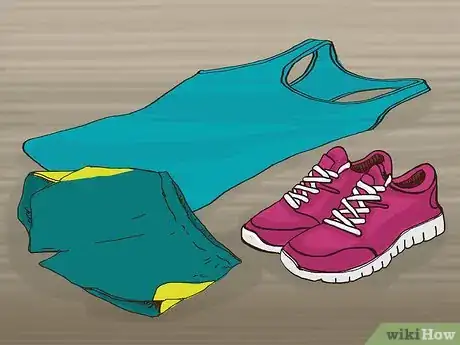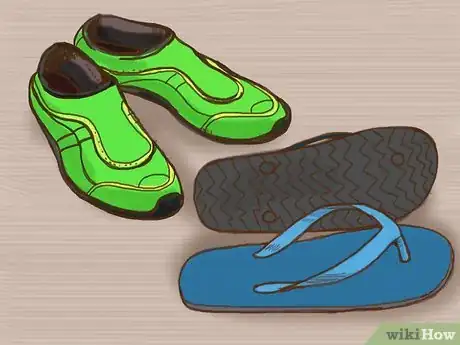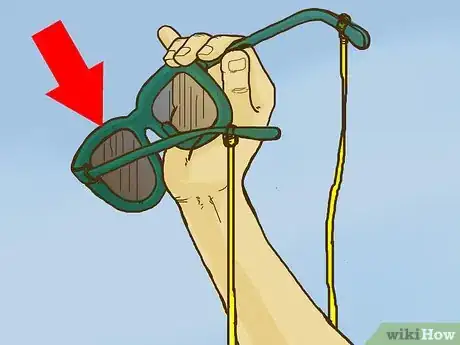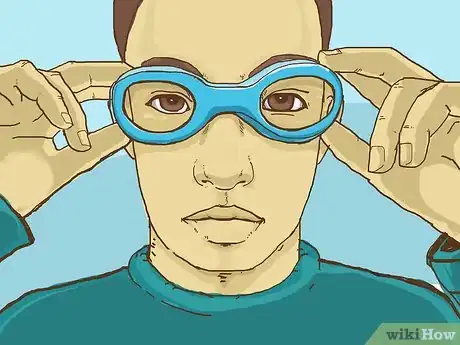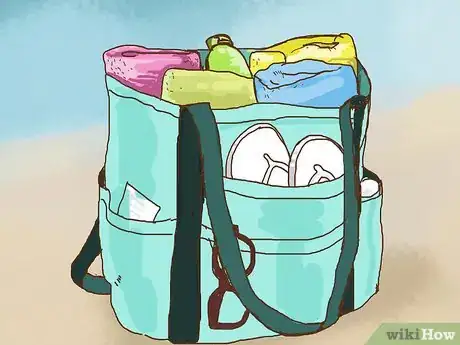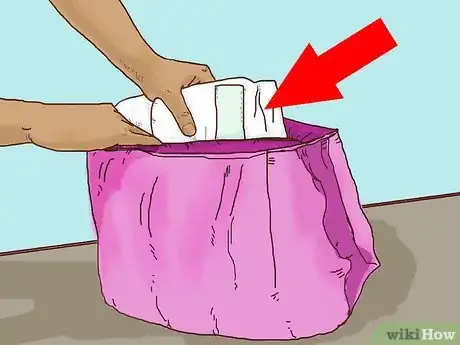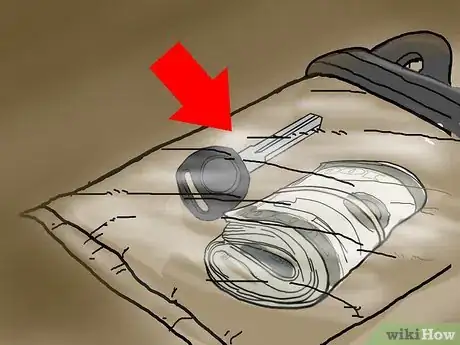This article was co-authored by Jami Yaeger. Jami Yaeger is a Parenting Specialist, Doula, and the Owner of AustinBorn, an online community offering comprehensive and modern education to growing families. With 10 years of experience, Jami specializes in whole family support for pregnancy, birth, postpartum, and parenting. Jami earned her BA in Theatre Performance from San Diego State University and earned her Certification as a Lactation Education Counselor from the University of California, San Diego. She is a Certified Infant and Child CPR Instructor, Birth and Postpartum Doula, and Childbirth Educator.
There are 16 references cited in this article, which can be found at the bottom of the page.
wikiHow marks an article as reader-approved once it receives enough positive feedback. This article has 11 testimonials from our readers, earning it our reader-approved status.
This article has been viewed 192,536 times.
When you’re planning for a trip to the water park, the most important thing to do is familiarize yourself with its regulations before you start packing. Read the park’s rules on their website – such as those regarding dress code and bringing food and drink into the park – or make a list of questions beforehand and then contact their guest relations department. Once you know how to comply, you can pack appropriately and not waste time preparing things you aren’t allowed to have in the park. Consider making a checklist as you review recommendations of what to pack for a water park, so that you don’t plan an item and subsequently forget to pack it. Overall, plan to be safe and have fun!
Steps
Clothing
-
1Choose your swimsuits. Water parks usually don’t allow guests to go into the water without swimwear. Always check the individual water park’s dress code before you begin trying on swimsuits that you may want to bring. They are the experts and have regulations in place for safety that you may not have considered. Pack swimsuits that fit well. Water slide attractions are more physical activities than swimming in a regular pool. You don’t want the suit to be loose enough to fall off or so tight that it rides up. Your bathing suit should be comfortable to walk around in – some parks don’t allow shirts or cover-ups on rides.
- Don’t bring swimsuits that have zippers, buttons, belts, rivets or metal ornaments. You may not be allowed to get on certain slides with them because they can cause damage to the equipment at the water park. Furthermore, you don’t want them to get caught on anything and cause your swimsuit to tear.[1]
- Bikinis are not recommended for water parks. They tend not to stay put on water slides, and some parks even forbid skimpy bathing suits. For females, one piece swimsuits are advisable. Look for suits with straps in a sports bra style so that they don’t slide off your shoulders. Avoid suits with ties that can come undone.
-
2Plan your outfits. You may want to arrive at the park with a bathing suit under your clothes so that it’s easier to get ready in the locker room. Choose casual clothing with a top that’s easily removable. Long-sleeved shirts and coverups can reduce your exposure to the sun. Keep in mind that you may not fully dry after going on water rides. Bring a comfortable jacket or sweatshirt so that you won’t be as chilly if the weather gets cooler as the day wanes.[2]
- If you’re going to an outdoor park, consider bringing a hat to help shield your face from the sun.
Advertisement -
3Bring a second set of clothes. Pack a change of clothes that will be easy to slip into later in case your clothes don’t dry. Include an extra pair of undergarments to go home in. If you’re going to divide up your day at the water park, consider bringing an extra set of bathing suits per person so that you don’t have to put back on a suit that is still wet.
- For example, tearaway athletic pants can be snapped on so that you don’t have to stand on one leg to put your pants on in a potentially wet locker room or bathroom.
-
4Take a set of sport clothes, if applicable. You may want to bring a set of sporty clothes and shoes for each person in addition to water apparel. Check out what activities the water park has to offer before you go. If the park has attractions that aren’t water-related, such as zip-lining, laser tag, or a ropes course, you will probably want to bring appropriate gear for that.
-
5Pack shoes. You will probably be walking around on concrete, and it may be hot if the park is outside, so you want to have a better plan than bare feet. Bring water socks, flip flops, plastic shoes or water shoes.[3] Keep in mind that depending on the park, you might not be allowed to wear water shoes on the rides or in the pools.[4]
- Have sandals with treaded or rubber soles to minimize your chances of slipping on wet walkways.
-
6Bring sunglasses. Consider bringing sunglasses with a strap if you want to wear them in the water where permitted. Polarized sunglasses will reduce the glare from the water. If you want to wear regular eyeglasses, you should confirm that you are allowed to wear them on rides. Some attractions may permit eyeglasses with a head strap only.
Swimming Accessories
-
1Bring towels. Bring at least one large, absorbent beach towel per person. Some parks ask you to bring your own towels, while others offer towels to use for free, for a rental fee, or by purchase. However, they may not be long enough to wrap around you or thick enough to dry you adequately. Your best bet is to bring your own; then you don’t even have to check ahead to find out about towel availability at the park.
-
2Find out about required and permitted flotation devices. Some water parks offer life jackets you can use for free. If you want to bring any pool noodles, water wings or inflatable pool toys with you, check with the park first to make sure they are permitted. If there are children coming with you, make sure to ask about flotation devices required for them.[5]
- Try asking, “Do children of a certain age or height need to wear life jackets or vests?” If the answer is yes, you can also ask, “Do the life jackets need to be Coast Guard approved? Are they provided at the water park, or should I bring my own?” If your child is a practiced swimmer, you may want to follow up these questions with, “Is there any type of swimming test exemption from this rule?”
- Water wings are considered swimming aids but should not be used as a replacement for life jackets or life preservers.
- Some water parks don’t allow swimsuits with built-in tubes.
-
3Pack goggles. You can wear swim goggles to shield your eyes from getting splashed on a raft ride. They are also great for using in wave pools. Mirrored, polarized and photochromatic goggles are ideal for outdoor swimming in the sunshine, while goggles that are merely tinted will offer medium protection in the sun.[6]
- Test the seal of your goggles by putting them over your eyes without strapping them on. Press the lenses gently towards your eyes. If the lenses maintain suction for a few seconds without you holding them into place, they will provide good protection against water leakage.
- Goggle straps are for keeping goggles on your head, not for keeping the seal suctioned. Make sure you can adjust the straps so that they stay put without being too loose or too tight.
Personal Items
-
1Wear sunblock if the park is outside. Bring sunblock with an SPF of 30 to 45. Look for a broad-spectrum sunscreen so that it will protect you against both UVA and UVB rays from the sun.[7] Choose a waterproof version. Apply your sunscreen a half hour before you’ll be outside, and bring it with you so that you can reapply it. Bring baby sunscreen if needed.[8]
- Reapply your sunscreen every two hours at least. You should put sunblock on again after getting out of the water and drying off.
- Make sure to reapply sunblock after riding any water slides.[9]
-
2Remember personal hygiene items. Water parks usually have showers in the locker rooms for washing chlorine off before you change into dry clothes. Consider bringing travel-sized body wash and shampoo. Chlorine dries out skin, so you might want to pack lotion to put on after you’ve dried off.[10]
- Bring enough feminine care products for the length of your stay, if needed.
- Other items you may want to bring are a hairbrush or comb, travel-sized conditioner, deodorant, and hair ties.
-
3Bring a beach bag or a backpack. A beach bag or backpack is handy for carrying around water shoes, sunscreen, snacks, and towels. Just don’t overpack your bag with weighty items that may hurt your shoulders to carry around for long periods of time. You may want to bring a fanny pack with you as well.
-
4Pack a diaper bag. If you’re travelling with a child who wears diapers, make sure to bring diapers specially made for swimming. These might be available at the water park you’re going to, but it’s much more economical to purchase them beforehand and bring them with you. Some parks may require wearers of swimming diapers to also wear swim pants.[11]
- Other items you may want to pack in the diaper bag: wipes, diaper rash cream, changing pads, a bib, baby food and spoon, bottle and nipples, pacifier, formula, blanket, and bath toys.
-
5Find out if you can bring food and drinks. If you want to bring your own food and/or drinks, check with the water park ahead of time and see if you’re allowed to do so. Ask if there are any regulations about what types of food or drinks you can bring, and what containers they can be in. Most parks allow you to at least bring bottled water. Alternately, you might be able to bring empty water bottles to fill at water fountains inside the park.[12] Consider bringing adult- and kid-friendly snacks, if not meals as well. Bring napkins, paper plates, and appropriate eating utensils as needed.
- Consider putting food and drink in a cooler lined with ice packs. Plan to stay hydrated: this can help prevent motion sickness. Check what type of coolers, if any, are permitted at the park first. Some parks may not allow coolers, or may allow soft foldable coolers only.[13]
- If the water park doesn’t allow food, find out if you can leave and re-enter the park without paying admission again. That way, you can still pack a cooler, and eat your meal in the parking lot or a nearby picnic area instead. If you plan to do the latter, bring picnic items as well, such as a tablecloth and clips.
- If the water park doesn’t allow food and you have dietary restrictions or are bringing an infant, find out if they make exceptions for such situations.
-
6Bring a stroller or wagon. Take a stroller with you if you have infants or toddlers. If not, consider bringing a wagon – whether you have children of age to be riding in one or not. You can use this as a handy way to cart around bags, souvenirs, a cooler, and more.
- You may want to check with the water park first to see if they have stroller or wagon rentals available, and where strollers and wagons can be safely stowed while you’re on a ride.
-
7Take motion sickness remedies. The motion of water and amusement park rides can cause uncomfortable motion sickness, such as nausea, dizziness and vertigo. The most effective way to combat motion sickness is to prevent it from happening. Consider taking an over-the-counter antihistamine 30 to 60 minutes before you arrive at the water park. Look for medication containing meclizine (Antivert) or dimenhydrinate (Dramamine).[14]
- Those most at risk for getting motion sickness are children ages 2 to 12, women (particularly when menstruating, pregnant or taking hormones), people prone to migraines, and those taking certain medications. Infants and toddlers are typically immune.[15]
- If you have a history of motion sickness or other reason to believe you may experience it at the water park, consider talking to your health care provider about a possible prescription option. Scopolamine is a transdermal patch which is put behind the ear four hours beforehand,[16] and is considered a first line of defense against motion sickness.[17]
Valuables
-
1Leave jewelry at home. You don’t want to risk losing or damaging your jewelry. You may not even be allowed to wear jewelry on certain rides. Your fingers will shrink in cold water, and if you’re wearing a ring it can easily slip off, especially if you’re riding water slides or going in a wave pool.[18] Water parks use chemicals like chlorine to keep water safe and clean, and these chemicals can damage the metal used in jewelry.[19]
- Don’t wear a watch to the water park. Even if the watch is labeled as “waterproof” or “water resistant,” there is no watch that is completely waterproof, especially when it will be submerged underwater forcefully at water park attractions.[20]
-
2Keep any necessary valuables in a plastic bag. Bring sealable, waterproof bags. Carry some money with you in case you want to buy food, beverages, souvenirs, or any items you may have forgotten to pack. Some water parks also take major credit cards for admission tickets, gift shops, and food. You may also want to rent lounge chairs or other equipment at park. Check with the park first about storage locker fees, since some storage lockers may only accept quarters.
- Bring two sets of keys to your vehicle, and keep them in different places. This is a safety precaution in case you lose a key.
- You may want to put money or a credit card, your license, a car key, and a cell phone all in one waterproof bag to be stored in your locker. Keep the key to your locker around your wrist throughout your stay at the water park.
-
3Decide if you want to bring your cell phone. You may want to leave your cell phone at home so that you don’t risk losing or damaging it. If you want to bring it, however, you should strongly consider leaving it either hidden in your vehicle, or in a locker at the water park. You might want to leave a car charger with it as well, if you think your battery may get low.[21]
-
4Consider bringing a waterproof camera. A disposable, waterproof camera would be less of a loss and less likely to get damaged than a smartphone or digital camera. If you’re planning to bring some type of camera, note that some water parks don’t allow selfie sticks or monopods. Bring film and/or batteries if your camera needs them.
Community Q&A
-
QuestionWhy would I need to use goggles in a wave pool?
 Community AnswerIn the wave pool, the water pressure is very strong. The water can get into your eyes faster than you think, and the waves will keep coming before you have a chance to clear your vision. Goggles will keep your vision from being impaired.
Community AnswerIn the wave pool, the water pressure is very strong. The water can get into your eyes faster than you think, and the waves will keep coming before you have a chance to clear your vision. Goggles will keep your vision from being impaired. -
QuestionHow do I prevent myself from forgetting to pack something?
 Community AnswerWrite down what you know you'll need and check it off as you pack. If you're not sure, do some research to find out anything you might be missing.
Community AnswerWrite down what you know you'll need and check it off as you pack. If you're not sure, do some research to find out anything you might be missing. -
QuestionWhat if I bring my cell phone?
 Community AnswerIf you're bringing your cell phone to a water park, it's a good idea to either store it in a locker or have it sealed in a Ziploc bag to prevent any water damage.
Community AnswerIf you're bringing your cell phone to a water park, it's a good idea to either store it in a locker or have it sealed in a Ziploc bag to prevent any water damage.
Warnings
- You should check the safety sign at each attraction to make sure that the ride is safe for your height and any health conditions you may have. If you can’t find the sign, ask a water park employee.⧼thumbs_response⧽
- Many water parks have specific rules against wearing apparel that has foul, obscene, illegal, profane, or otherwise unacceptable words or images.⧼thumbs_response⧽
- Make sure to follow the warnings and instructions on the label of any over-the-counter medications before taking them. First-generation antihistamines are sedating and there may be specific advisories that relate to your health situation.[23] Non-sedating antihistamines are ineffective for treating or preventing motion sickness.[24]⧼thumbs_response⧽
- If you want to smoke or drink alcoholic beverages, find out what the park’s regulations are first. The park may be non-smoking or have a designated smoking area. Most parks don’t allow you to bring alcohol beverages into the water park, but they may allow you to purchase beer, for example, at a restaurant or food stand inside the water park. It isn’t advisable to drink alcohol if you’re taking antihistamines, since it can increase symptoms of drowsiness.[25]⧼thumbs_response⧽
References
- ↑ http://www.ultimatewaterpark.com/waterparks/tips-advice.php
- ↑ http://traveltips.usatoday.com/pack-trip-water-park-105651.html
- ↑ http://www.ultimatewaterpark.com/waterparks/tips-advice.php
- ↑ http://traveltips.usatoday.com/pack-trip-water-park-105651.html
- ↑ http://getawaytips.azcentral.com/pack-trip-water-park-4790.html
- ↑ https://www.simplyswim.com/docs/ChoosingGoggles.aspx
- ↑ http://www.mayoclinic.org/healthy-lifestyle/adult-health/in-depth/best-sunscreen/art-20045110
- ↑ http://www.webmd.com/beauty/features/high-spf-sunscreens-are-they-better
- ↑ http://www.ultimatewaterpark.com/waterparks/tips-advice.php
- ↑ http://traveltips.usatoday.com/pack-trip-water-park-105651.html
- ↑ http://www.ultimatewaterpark.com/waterparks/tips-advice.php
- ↑ http://www.ultimatewaterpark.com/waterparks/tips-advice.php
- ↑ http://wwwnc.cdc.gov/travel/yellowbook/2016/the-pre-travel-consultation/motion-sickness
- ↑ http://www.mayoclinic.org/first-aid/first-aid-motion-sickness/basics/ART-20056697?p=1
- ↑ http://wwwnc.cdc.gov/travel/yellowbook/2016/the-pre-travel-consultation/motion-sickness
- ↑ https://medlineplus.gov/druginfo/meds/a682509.html
- ↑ https://www.ncbi.nlm.nih.gov/pubmed/25077501
- ↑ http://www.marthastewartweddings.com/229012/caring-your-engagement-and-wedding-rings#373193
- ↑ http://www.gia.edu/gia-news-research-Secrets-Keep-Diamond-Sparkling
- ↑ https://www.ftc.gov/sites/default/files/documents/federal_register_notices/guides-watch-industry-16-cfr-part-245/990609guidesforthewatchindustry.pdf
- ↑ http://www.ultimatewaterpark.com/waterparks/tips-advice.php
- ↑ http://www.familyvacationcritic.com/top-10-tips-for-water-parks/art/
- ↑ https://www.ncbi.nlm.nih.gov/books/NBK50554/
- ↑ https://www.ncbi.nlm.nih.gov/pubmed/25077501
- ↑ http://www.nhs.uk/Conditions/Antihistamines/Pages/interactions.aspx
About This Article
To pack for a water park, make sure you pack a swimsuit since some water parks won't let you in the water without one. You'll also want to pack an extra set of clothes so you have a dry outfit to change into at the end of the day. Also, pack some water shoes or flip flops so you don't have to walk around the park barefoot all day. Don't forget to bring towels to dry off, sunscreen to protect yourself from the sun, and sunglasses in case it's really bright. To learn how to pack any valuables you're taking to the water park, scroll down!



